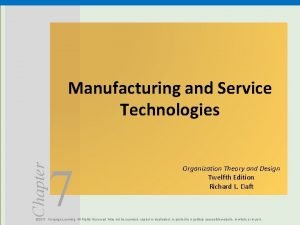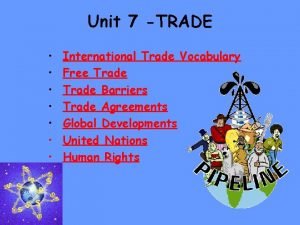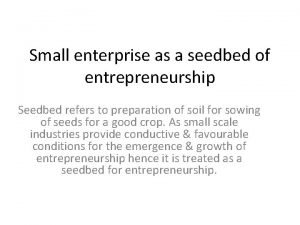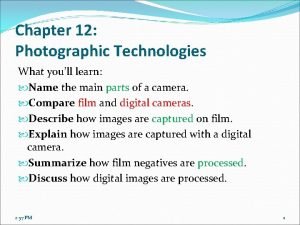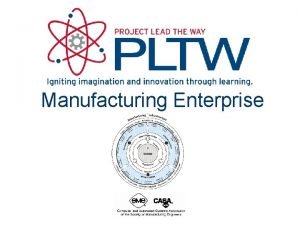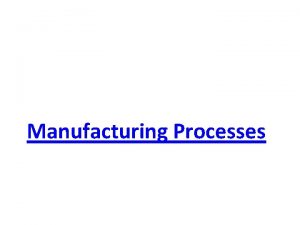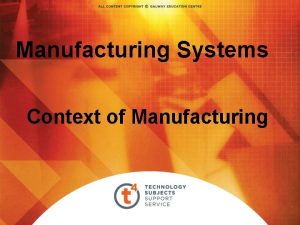Chapter 16 Manufacturing Technologies What youll learn Discuss






























- Slides: 30

Chapter 16: Manufacturing Technologies What you’ll learn: Discuss how manufacturing evolved. Explain the difference between durable and non-durable goods. Discuss the importance of assembly lines and division of labor. Describe manufacturing systems using the universal systems model. Explain the concept of added value. Describe several manufacturing tools and processes. Describe general steps in setting up and running a small factory. Explain the function of market research, quality assurance, and just-in-time delivery.

Section 15. 1 The Evolution of Manufacturing

Manufacturing and the Modern World Why is manufacturing essential to our way of life? Most of the things we use every day were manufactured in factories. Manufacturing makes it possible to have a modern way of life. Without factories, we would not have cars, clothing, televisions, breakfast cereals, books, microwave ovens, or cell phones.

Manufacturing and the Modern World Products and Consumers Manufactured products are sent to stores. Consumers are people who buy and use the products. We consume products by using soap, wearing clothes, and reading books. Without consumers, there would be no manufacturers.

Manufacturing and the Modern World Durable and Non-Durable All products are either durable or non-durable. The US federal government defines durable goods as those expected to last three years or longer. Television sets, hammers, and bicycles are all examples of durable goods. Non-durable goods are expected to last less than three years. Calendars and packaged foods are examples.

Early Manufacturing How has the evolution of manufacturing changed society? The products that people used in the past were not always made in factories. People had to make their own fabric for clothing, farming tools, candles, wagons, furniture, and even their children’s toys. It took a long time to make each item. Not everyone could do a good job at making so many different things. Some people could make good wagons but not good tools. Others were better at making cloth. People soon began to specialize in just one type of craft, such as wagon making or shoemaking.

Early Manufacturing The Industrial Revolution Around 1750, great changes started to take place around the world because of new methods of manufacturing. Because new methods were so important, that period of time is called the Industrial Revolution. Goods once produced by hand were then produced by machines in factories. Cities grew in size when factories drew people from farms to cities. The Industrial Revolution was a great turning point in the history of the world, and it caused many social changes. It changed the U. S. economy from an economy based on farming to one based on industry. However, factories were wasteful of workers’ efforts.

Early Manufacturing Improvements in Manufacturing As factory production increased, people began to look for better ways to do things. Frederick Taylor was the first person to develop standard ways of doing things. He made it easier for workers to manufacture products. Taylor’s method is called scientific management and is an important part of modern factories. The husband-wife team of Frank and Lillian Gilbreth also worked on better ways of doing things. They worked in the new field of time and motion study. Time and motion study is a method of finding the way to do a job in the shortest time with the fewest movements. The Gilbreths improved factory working conditions and developed many techniques to measure factory efficiency.

Modern Manufacturing How can all factories be different and similar at the same time? Early experts provided the foundation for establishing factories to manufacture products. However, each product is different and requires different materials and methods.

Modern Manufacturing Division of Labor Many companies use a division of labor. This means dividing the work into smaller steps done by certain groups of people. A person who is good at electrical wiring will wire while someone good at painting will paint. Sometimes a flow chart is drawn showing the steps for producing the product and how they relate.

Modern Manufacturing Assembly Lines Many companies use assembly lines or some type of assembly operation. In an assembly line, the workers often stay in one place and work on the product as it passes by. Automobiles and vacuum cleaners are put together this way. Some products are assembled automatically by machines. For example, most medicines and foods are automatically processed and packaged. Other products do not lend themselves to an assembly operation. Examples include gas, paint, and tissue paper.

Modern Manufacturing Quality Control During the manufacturing operation, each company makes many checks on the product’s quality. A company making canned soup has to keep the machinery and the food very clean. The product has to taste good and be nutritious. Such companies also have strict governmental regulations they must follow regarding content, safety, and portion size.

Section 16. 2 Organizing a Manufacturing System

Inputs What inputs are needed by manufacturing systems? All manufacturing companies use the same system inputs to produce their products. They are 1. people, 2. materials, 3. tools and machines, 4. energy, 5. information, 6. capital, and 7. time.

Inputs People Larger companies have many engineers and technologists. Some people design the products the companies make. They are called “design engineers” or designers/drafters. ” Production engineers decide the best way to manufacture the products. Quality control engineers and technicians inspect the product. Many people operate manufacturing machinery, while others set up or adjust the machines. Then people distribute and sell it.

Inputs Production Materials The materials companies use to make their products are called production materials, or engineering materials. They are different from raw materials. Raw materials are materials in their natural state, such as iron ore, trees, and raw cotton. Most production materials have already been processed to some degree. For example, trees have already been cut into lumber and dried. Materials are chosen for their different properties. Plastic used to make balloons, for example, has to be soft and stretchy.

Inputs Production Materials: Added Value Companies stay in business by adding value to production materials. Added value is the increase in a material’s worth after it has been processed into a finished product. For example, a nail is a one-piece product made from a roll of strong steel wire. A nail-making machine puts a point at one end and flattens the other end. Companies add value to steel wire by changing it into nails.

Inputs Production Materials: Combining Materials Other companies combine several different materials or make a product with many different parts. An ordinary flashlight has ten parts: plastic base, top, lens, switch, lamp (bulb) holder, spring, two flat pieces of metal, lamp reflector, and metal lamp conductor. The two batteries and lamp are purchased from other companies. Some companies make products that have hundreds, or even thousands of parts.

Inputs Tools and Machines During manufacturing, tools and machines change the shape of materials and fasten them to other materials. Hand tools, portable power tools, and machine tools and their many purposes are discussed in Chapter 3. Machine tools are bolted to the floor and operated by electric motors. They are some of the most important tools used in a factory. Some are as large as a room. Others are smaller, such as a drill press. A portable power tool uses a small motor for power and is usually handheld. Some power tools, such as a table saw, cannot be held in your hands or easily moved. People use power tools for such jobs as sanding flat surfaces

Other Inputs Energy is needed to run machines, heat buildings, and provide light. Capital (money) is needed to build factories, buy production materials, and pay workers. Of course, time is needed to do all the different jobs. Another important input is information. Workers need information in the form of drawings and instructions to make products.

Processes What are some manufacturing processes? Almost everything that takes place during manufacturing involves processes. Someone has to design and develop the product. Other people must organize and manage all the jobs that are done, make the product, and distribute and sell it. After the consumer has bought the product, another process involves servicing the product or making any repairs to a product that is returned.

Processes: Changing Size and Shape The shape or size of materials is often changed by cutting, bending, casting, forging, or extruding, which are processes discussed in Chapter 3. Abrading means to scrape or rub off small pieces. Filing, sanding, and grinding remove material by abrading it.

Processes Chemical Processing Conditioning is another process discussed in Chapter 3. Conditioning changes materials by using chemicals. Chemicals are used for etching the circuit boards in your computer. Plastics are often processed from chemicals. The basic material is called a resin. Other ingredients are added to produce special properties, such as strength.

Processes Fastening is combining two or more parts together. Furniture, for example, is fastened together with nails, screws, and glue. Plastic parts can be fastened with snaps. A small extension on one part snaps into a hole in another and holds everything together. Plastic and metal parts can also be fastened by melting. Some plastic CD or DVD cases are heated and melted together. No mechanical fasteners or adhesives are necessary. Many metal parts of a car body are welded (melted) together with high heat.

Outputs and Feedback What outputs and feedback are part of a manufacturing system? The products themselves are the main outputs of a manufacturing system. Another is providing jobs for a community. Waste or pollution might be another. Feedback can also come in many forms. High demand or low demand for the product is part of feedback. The manufacturer must review what went right or wrong to determine if changes need to be made to the product and system. What changes might be needed if a product is too successful?

Section 16. 3 Running Your Own Factories

Market Research How can you find out what products people will purchase? Suppose you have an idea to manufacture a product and sell it to others 1. You plan the product and make sketches. By putting your idea on paper, you can show others what you are thinking. The drawing is part of your design. 2. You want opinions from other people, so you talk to your friends and colleagues. Each person gives you suggestions for how to improve your product. This is market research. Market research is a way to find out what people will purchase. 3. You make product prototype to test. After you make some changes, you are ready to produce.

Manufacturing the Product Suppliers are persons or company that provide materials or products to help you manufacture your own products. Most manufacturers use just-in-time (JIT) delivery and receive those items just in time to do the work. With JIT, not need extra warehouse space to manage items. Get your production materials together. Now you go into production. You have added value to the materials. Carefully inspect each finished product. This inspection is called quality assurance or quality control. It means the product will meet the requirements, or standards. Quality assurance is crucial to manufacturing. It enables you to use information about your system to change it as needed.

Marketing and Sales What is involved in marketing your product? Marketing is a way to tell people about a product. One way to do this would be to create flyers and post them where they will be seen. You drop off your products at each of the stores that agreed to sell them. The store owners will charge you commission. A commission is payment based on sales. How much profit will you make? Profit is the money left over when all your bills are paid.

 Amateurs talk strategy professionals talk logistics
Amateurs talk strategy professionals talk logistics Manufacturing cost vs non manufacturing cost
Manufacturing cost vs non manufacturing cost Process costing definition
Process costing definition Controllable expenses examples
Controllable expenses examples Manufacturing cost vs non manufacturing cost
Manufacturing cost vs non manufacturing cost Additive manufacturing steps
Additive manufacturing steps Current and future trends of media and information ppt
Current and future trends of media and information ppt Kinesthetic learners learn best by
Kinesthetic learners learn best by Manufacturing and service technologies
Manufacturing and service technologies Percy jackson and the olympians chapter 6
Percy jackson and the olympians chapter 6 Learn to lead chapter 6
Learn to lead chapter 6 “i hope i never will. i hate careless people.”
“i hope i never will. i hate careless people.” Symbols in the great gatsby chapter 3
Symbols in the great gatsby chapter 3 What do we learn about candy in chapter 2
What do we learn about candy in chapter 2 How does nick describe the guests at gatsby's party
How does nick describe the guests at gatsby's party It infrastructure and emerging technologies
It infrastructure and emerging technologies Emerging technology chapter 5
Emerging technology chapter 5 Chapter 5 it infrastructure and emerging technologies
Chapter 5 it infrastructure and emerging technologies Work in pairs and answer the question
Work in pairs and answer the question Is free trade fair? discuss
Is free trade fair? discuss Qatar karta
Qatar karta What is the difference between guidance and counselling?
What is the difference between guidance and counselling? Travel motivators and demotivators
Travel motivators and demotivators Discuss how permanent hardness of water can be removed
Discuss how permanent hardness of water can be removed Emotional events
Emotional events Discuss the tlc project
Discuss the tlc project Decorative design
Decorative design Lifelong process of social interaction
Lifelong process of social interaction Small scale entrepreneurship
Small scale entrepreneurship Rivals as comedy of manners
Rivals as comedy of manners Removing room service equipment description
Removing room service equipment description








